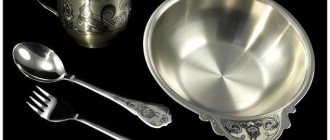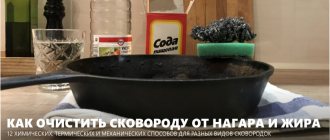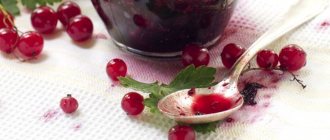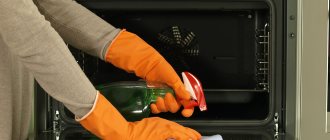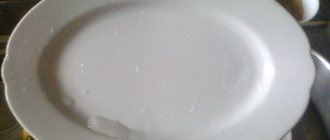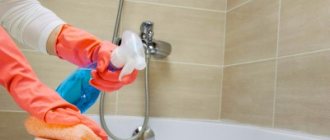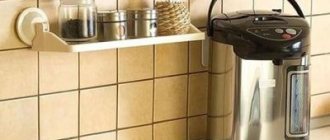Depending on the material the pan is made of, there are different methods for cleaning up burnt-on grease. Cast iron pans hold up very well to harsh chemicals and traditional methods, while aluminum pans can only be washed with a very specific method. Teflon pans are easily damaged by mechanical action, so chemical methods are preferable. For cleaning, laundry soap, ammonia, peroxide, office glue, activated carbon, soda, salt, soap suds and professional products are used.
Before you begin, the goal should be to remove any burnt-on fat from the pan without damaging its surface. Depending on the material from which the product is made, different methods are relevant.
Soda and salt
Baking soda and salt are used as abrasives that can physically break down even very thick layers of burnt fat.
Soda and salt
To do this, pour some hot water into a frying pan and add a moderate amount of dry baking soda or salt to create a saline solution. Using a stiff sponge, rub the powder evenly into the fat until the sharp edges of the crystals begin to break it up. Periodically, dirty salt and soda are washed off from the pan with washed pieces of fat, after which the processing begins again.
Baking soda itself is very active. Chemically, in the presence of hot water, it is able to break down fat, dissolving it into a liquid. The effect is enhanced by adding vinegar to baking soda - a violent reaction can greatly dissolve fat and wash away even goose crust from a frying pan or a greasy plate from the hood and ventilation ducts.
How to remove using folk recipes?
Homemade recipes for cleaning the oven use those products that are available in the household.
When choosing a method of exposure, the degree of contamination of internal surfaces should be taken into account.
Dishwashing gel
This method of cleaning the oven is suitable for regular cleaning in order to maintain cleanliness and prevent the formation of thick deposits. But with old deposits this method will not be effective.
Procedure:
- prepare a solution of 1 liter of water and 1 tbsp. l. gel;
- beat the composition into foam;
- distribute the product over surfaces using a sponge;
- rub;
- rinse thoroughly with water;
- wipe dry.
Vinegar and soda
To remove mild to moderate carbon deposits, you can use several stages of cleaning:
Dilute a pack of soda with water to make a very thick paste.- Apply the composition to internal surfaces. For old carbon deposits, the layer of product should be thick.
- Leave to stand for 10 hours.
- Clean using a sponge and plastic scraper.
- In a separate container, mix 0.5 cups of water and the same amount of vinegar.
- Pour the resulting solution into a spray bottle.
- Spray the vinegar solution onto the oven walls. In this case, foam formation should occur.
- After the reaction is complete, the oven must be washed and dried.
Using this method requires a lot of time, during which the oven cannot be used.
Ammonia
The use of ammonia will remove even old carbon deposits. This method requires preliminary preparation:
- organizing good ventilation of the room;
- mandatory use of rubber gloves;
- use of respiratory protection.
Cleaning steps:
- Preheat the oven to 200ºC.
- Pour 5 bottles of ammonia into a heat-resistant container.
- Place the container in the lower part of the oven.
- Turn off the oven.
- Leave to stand for 12 hours.
- Remove the container from the oven.
- Using baking soda, wipe all surfaces with a sponge.
- Rinse with water and wipe.
It will take quite a long time to ventilate the oven after such treatment.
Method with citric acid
Citric acid can be used to remove carbon deposits. The best result with this treatment is achieved by heating the oven.
Processing technique:
set the oven heat to 200ºС;- pour a solution of 0.5 liters of water and 20 grams of acetic acid into a wide fireproof container (for example, into a baking tray with sides);
- place the container in the lower part of the oven;
- close the door;
- wait until the water boils;
- after the solution boils and water droplets appear on the inner surface of the glass, turn off the heating;
- wait until the oven cools down;
- wipe all internal surfaces with a sponge;
- ventilate.
The cleaning effect can be enhanced by spraying the walls with a concentrated vinegar solution prepared in a 1:1 ratio.
Laundry soap
Dishwashing soap is a universal remedy for removing any dirt, including grease burned on the bottom of pots and pans. It’s unlikely to cope with a very thick layer of soap, but you can deal with a fresh one.
laundry soap
Rub a piece of laundry soap on a medium grater in a deep clean bowl and add a little hot water. The mixture is stirred until a homogeneous thick mass is formed, which turns into soot. It is better to leave the pan in this form for several hours for the soap to work properly. When the paste is completely dry and crusty, rinse it with hot water along with some oxidized grease.
Laundry soap is low-active, so it will not be possible to remove soot right away. This procedure will have to be repeated several times.
What causes grease and carbon deposits on the walls of a frying pan?
The reason for the appearance of soot is simple - sloppiness and unwillingness to wash the dishes immediately after cooking. The layer of fat that settles on the walls and bottom gradually increases and mixes with soot, creating an explosive mixture harmful to the body. The appearance of such contaminants in pans occurs in a similar way. Therefore, cleaning kitchen utensils should become a habitual and mandatory procedure for everyone.
Liquid products
In the household appliances departments of hardware stores, special liquids are sold that are designed to dissolve even the hardest fat deposits. The components of the liquid actively react with fat, dissolving it before our eyes. These products are much more effective at descaling a frying pan than traditional methods, but their cost is very high.
Carbon remover
Such measures are recommended to be applied either to branded dishes, or if traditional methods do not hit the scale. A clean Teflon frying pan greased with it is preferable due to the harmfulness of the ceramic coating.
Cleaning the oven with laundry soap
Laundry soap consists only of natural ingredients, so its use is absolutely safe. Because of its alkalinity, it copes well with burnt fat. To use it you will need laundry soap and clean water:
- Grate half a bar of soap and dissolve in hot water;
- place the solution in a heat-resistant container and heat in the oven;
- boil the solution for 45 minutes at a temperature of 150 degrees;
- all contaminants should soften well and flow down the walls of the oven;
- remove fat with a hard sponge;
- thoroughly rinse all walls with water several times;
- Do not close the oven at night so that all the smell of laundry soap disappears.
You can wash away old stains using a mixture of vinegar, soda and laundry soap . To do this, you need to mix 100 g of vinegar, 50 g of soda and 70 g of laundry soap, which is first crushed using a grater. The resulting composition is intensively rubbed into the dirt and left to soften it for a couple of hours.
After this, the layer of fat can be easily removed with a rag. This method can be used to clean the oven not only inside, but also outside.
Sprays
Special products are sold not only in the form of liquids in bottles and cans, but also in the form of sprays.
Spray for removing soot and grease
The grease cleaner is sold in a special container with a convenient spray nozzle, which allows you to economically and evenly apply the liquid to the surface of the container. This can make it much more economical to mop up grease from the pan with a spray.
Safety rules for cleaning dishes from carbon deposits and grease
Cleaning dishes requires compliance with safety precautions:
- When working with chemicals, wear gloves and maybe a face mask;
- During the procedure, it is worth opening the window;
- There should be no animals or children in the kitchen;
- At the end of cleaning, all working surfaces must be washed with soap.
The most obvious and effective means of prevention is the timely removal of greasy stains.
Gels and creams
The most concentrated professional products are produced in the form of gels and creams, which are designed for quick and effective cleaning of pans from fatty deposits of any complexity.
Gel for removing fat deposits.
They can be applied outside or inside the surface of the frying pan with gloved hands or a special brush. Fat, which loves to stick to metal, will literally dissolve before your eyes, leaving residue that needs to be washed off with plain water.
Dishwasher tablet or laundry detergent for cleaning pots
Household cleaning products such as dishwasher tablets or laundry detergents in high concentrations are effective. This method works especially well for stainless steel cookware. However, laundry detergent should not be used to clean burnt aluminum and enamel pans.
How to wash dishes
? Sprinkle a few tablespoons of powder into the bottom or crush up one dishwasher-safe tablet, then fill with a little warm water. The resulting solution can be left overnight, and in the morning washed with a sponge and rinsed thoroughly. To speed up the process, bring the dissolved detergent to a boil for several minutes.
Foam cleaning
The foam contains surfactants designed to remove stubborn stains from household pots.
Washing a pot with foam
Foam from regular dishwasher detergents will deal with this quickly, as will the special products described above. The foam usually has a quick but short-lasting effect, allowing you to clean the surface of a non-stick pan of fresh grease.
Lemon acid
It is gentle on the surface of the stove, but harmful to fat.
Acid breaks down plaque and also has a good abrasive effect, which additionally removes dirt.
Necessary:
- Moisten the stain with a damp sponge.
- Apply a tablespoon of citric acid granules.
- Let stand for 3-5 minutes, then walk over the surface with the hard side of the sponge.
To increase abrasiveness, citric acid can be mixed with coarse table salt and the manipulation can be repeated.
Advantages:
- A safe method that does not cause irritation upon contact with exposed skin.
- Removes old stains well.
- Makes the surface glossy.
- Gives a pleasant lemon aroma.
Flaws:
- Not suitable for daily cleaning as it contains a high level of acidity.
Expert opinion
Borodina Galina Valerievna
If there is a lemon left in the refrigerator that will no longer be used for food, you can cut it into pieces and walk over the dirty surfaces of the stove. Light stains will quickly disappear even without a sponge, and the hob will get a shine.
Activated carbon
Activated carbon is another folk remedy that can cleanse the inside and outside of fresh and old clots of fat.
Activated carbon
The pan is soaked in water, a large amount of active carbon is applied to the oil surface, after which the pan is left for a long period of time.
It is advisable to leave the pan with activated carbon overnight.
Which cleaning method should I choose for a specific type of pan?
Stainless steel pans
are the least demanding and can be cleaned with vinegar, baking soda, baking powder, washing powder, dishwasher tablets, activated carbon, salt or citric acid.
Enameled pans
are more delicate and you should not use vinegar, washing powder and Coca-Cola to clean them. It is best to use salt, baking soda or a dishwasher tablet.
Aluminum pans
, which are becoming increasingly rare in our kitchens, cannot be cleaned with washcloths and rough sponges, as well as soda, baking powder and washing powder. However, you can use vinegar, salt and dishwasher tablets to clean them.
How to wash a burnt ceramic pan
? Do not use salt, which can damage the ceramic coating; it is recommended to use a water solution of soda or vinegar.
How to clean a cast iron pan
? It is best to boil water in it or use wet soda. Cast iron can also be washed with dry salt using a brush or potato.
On burnt Teflon-coated pots or pans
Cleaning with carbonated water is effective; carbon dioxide during heating helps to peel off burnt residues. You can also use a suspension of salt and water, leave it overnight and then rinse gently.
Cleaning with office glue
Stationary adhesive can significantly improve the properties of laundry soap.
Stationary glue
Based on it, a special solution is prepared, in which you need to prepare a frying pan with a greasy residue or a frying pan with burnt jam. A piece of laundry soap is rubbed into a container that can fit a frying pan. Several tubes of writing glue were also added there. The mixture is stirred until a homogeneous mass is formed, into which the frying pan is placed.
Carefully! When preparing dishes, the hood must be running; glue vapors can be toxic to the human body.
After a while, remove the pan, add plenty of water and a metal scraper to remove any remaining fat, and dry thoroughly.
In addition to glue, you can use ammonia and hydrogen peroxide.
Ammonia
A simple but very effective remedy that will help dissolve a dense layer of fat and facilitate its removal.
Required:
- Add 1 tablespoon of ammonia to a glass of warm water.
- Apply the solution using a spray bottle or a dampened sponge to the surface.
- Cover the area to be treated with film or a bag.
- Let stand for 30 minutes, after which remove any remaining fat with a sponge.
Ammonia has a strong and unpleasant odor, so it is important to use a respirator and also open a window while using the solution.
Advantages:
- Quickly dissolves fat, copes with long-standing deposits and soot.
- Does not harm the surface of the stove.
- Can be used every time you clean.
- Removes unpleasant odors, makes the surface glossy and sparkling.
Flaws:
- Requires good ventilation in the room, as well as the use of a respirator.
If the layer of fat is very dense, there is soot and other types of contamination, the concentration of ammonia can be increased (up to 1:1 with water).
How to clean an aluminum pan
Aluminum reacts well to grease buildup and is very difficult to clean. Regular lubricants will not work on aluminum pans, so you should choose an aluminum cleaner, such as Aluminum Pots and Pans, or a household cleaner.
Aluminum pallet
You can also remove any grease from the aluminum using a blower to ensure the pan heats evenly on all sides.
Rice as a way to clean dishes
Among home remedies for burnt dishes, a somewhat unusual but effective cleaner is rice.
How to wash burnt dishes with rice?
Just pour a handful of rice grains into the bottom of the pan, fill them with a small amount of water, such as half a glass or a glass, depending on the diameter of the pan, and cook.
Once the rice has softened after a few minutes of cooking, you can cool the pan and remove the contents. The last step is standard dishwashing using a mild detergent.
This method can be used on any type of cookware, but be careful not to burn it again.
How to clean a cast iron frying pan from years of carbon deposits
A cast iron skillet can be cleaned using all the methods described above.
Cast-iron pan
Do not use metal scrapers to forcefully remove grease as this may damage the cast iron saturation guard. The oil layer is restored by heating a frying pan with a large amount of sunflower oil until a large amount of soot forms.
Vinegar for a burnt pan
An effective method for cleaning burnt dishes is to use table or wine vinegar. This liquid does an excellent job of removing carbon deposits in steel and aluminum pans. However, it should not be used to clean enamel pans, as vinegar may cause the enamel to become dull.
How to clean a burnt pan with vinegar?
Simply pour a small amount of water with vinegar into the bottom of the dish, up to a height of two or three centimeters, and boil. After boiling for a few minutes, the solution should be cooled and left overnight. In the morning, simply pour out the mixture, carefully remove, for example, a wooden spoon, the remaining dirt and wash the pan with a cloth or sponge.
How to clean a ceramic frying pan
Ceramic cookware has the ability to repel grease from each other, which significantly speeds up cleaning.
Ceramic frying pans
Teflon models have these properties, which prevent grease from accumulating. Such frying pans are very sensitive to mechanical cleaning and sudden temperature changes, so cleaning a Teflon frying pan will be difficult for beginners.
How to properly prepare a frying pan for cleaning.
First, it is necessary to remove all contamination that does not belong to the burnt layer. It is best to soak in water, since softened food particles will very easily separate from the soot itself, and the weaker parts of the soot can dissolve in water. You should not try to tear off or try to clean the frying pan mechanically - the problem of damaging the top protective layer will certainly arise. And if you don't remove extra pieces of food from the pan, they will simply make cleaning difficult. It is also very important to start cleaning only after the dishes have cooled completely.
Some of the methods involve heating, but this does not mean that a frying pan on which something has just burned will respond well to contact with cold water (warm water will also seem cold). It is better to spend some time on this, but avoid deforming the surface. Of course, it is worth separating the wooden or plastic handles to avoid damaging them, since they do not need such thorough cleaning anyway. This can reduce the distance the pan occupies when soaking. If the handle still needs cleaning, it is better to do it in a separate mode - this way you can better clean the dirt when a heavy frying pan does not interfere, and do this using suitable methods.
Rating of popular household products
Today, the choice on the shelves of household chemicals in supermarkets is so wide that we have compiled for you a rating of the best household products that will help you quickly and easily clean the oven from dirt.
When compiling the rating, we took into account reviews on the sites Irekmend and Otzovik. Shall we begin?
Reinex
Active foam for cleaning stoves and ovens Reinex, according to reviews, is a real godsend for those who need to clean a heavily soiled oven.
All you need is to apply the contents of the can in an even layer on the contaminated surfaces and leave for twenty to forty minutes. The waiting time depends on how much the surface needs cleaning.
Then simply wipe off the product with a soft sponge and wipe with a clean, damp cloth. Ready!
A nice bonus for owners of steel ovens - Reinex gives metal surfaces a shine that lasts quite a long time.
SanitaR
Sanitar gel for cleaning ovens, stoves, barbecues, cauldrons, frying pans, and hoods is a favorite of many housewives. First of all, due to its versatility - the manufacturer claims that the product contains substances that can be used on surfaces in direct contact with food.
According to reviews, the product can dissolve even old grease stains and carbon deposits in just 10 minutes. You just need to apply it to the surface and wait a little.
Another undeniable advantage is the low price. A bottle of gel, which is enough for several months of use, will cost you less than 200 rubles.
However, many warn that you need to be careful with this product when treating combined surfaces where plastic is present - for example, the outside of the oven. Plastic parts may “melt” slightly under the influence of the product.
True, it is not clear how this is combined with the manufacturer’s assurances about the complete safety of the product.
Faberlic
One of the best products in our rating is gel from Faberlic. The main advantage of this detergent is that it is absolutely odorless. This means that the gel can be used by allergy sufferers.
At the same time, many note the amazing effectiveness of the detergent - it removes old grease stains in just five minutes without much effort. It is enough to apply the gel, and then gently wipe the area with a damp sponge and wash away any remaining product.
At a cost of 170 rubles, the gel is quite economical - just a few drops are enough to clean the inside of the oven.
However, there is a problem with application - the bottle does not have a dispenser, so more product is often poured out than planned. On the one hand, this is an extra consumption of detergent. On the other hand, the product foams too much. However, the problem is easily solved if you buy a dispenser or pour the gel into another container.
Frosch
This product is mentioned quite often in various reviews - the manufacturers promise that even the oldest fat is removed in a couple of minutes.
However, reviews refute this statement - to achieve results, the gel must be kept on for at least half an hour. In addition, after this, rub the dirty areas quite intensively.
For a product that costs 270 rubles, this is a rather dubious result, to be honest. Among the advantages, many note the pleasant aroma of grapefruit and a convenient, economical dispenser.
In general, the gel is not bad - however, many folk remedies showed approximately the same results.
Mister Muscle Expert
The universal kitchen detergent Mister Muscle Expert will cost you a little more - about three hundred rubles. However, it fully justifies its price.
It dissolves fresh grease stains in the oven in about a minute; with older ones, it is recommended to leave the product for about ten minutes. After this, even the oldest stains of grease and soot can be easily removed with a simple rag.
The product emits a pleasant citrus aroma, sprays well and is quite economical - a bottle lasts about six months.
Another advantage is that it can be used not only for the oven, but also for other kitchen surfaces.
Schumann
The concentrated grease remover “Shumanit” at one time created a real sensation - it seems that almost everyone tried it. It costs about 400 rubles per five hundred milliliters. Considering its effectiveness, the price is more than humane.
The product is really more than effective - just spray it on the dirty surface for a few minutes, then wipe it with an abrasive sponge and wipe dry with a clean cloth. Old stains of grease and soot will require a little more time - as much as three minutes.
At the same time, Schumanite dissolves even very old stains - the author of this article used it to wash the grille of a hood that had not been opened for more than three years, spending only half an hour.
It is sprayed onto the surface using a dispenser, quite economically. To clean the inside of the oven, six sprays are enough, and about three sprays to clean the outside.
In general, we definitely recommend purchasing.
Bonus: Schumanite is best used on metal surfaces. On them it acts as a polish, providing a bright shine.
Eco-max
The Canadian Eco-max gel primarily attracts attention for its versatility: it can be used to wash dishes, clean the oven and even freshen carpets. It does not contain chemicals and is therefore considered absolutely safe.
The cost starts from 500 rubles per jar. The product is quite effective, but it does not always cope with old stains unless additional efforts are made. You will likely have to rub the treated stains for a few minutes.
The product is not bad, but it is unclear why you should pay for a mixture of soap, soda and citric acid, if it is much cheaper to prepare such a mixture at home.
Krizalit Eco
Another eco-friendly product in our rating is Krizalit Eko. Its price fluctuates around five hundred rubles per half liter.
It is distinguished from its analogues by its mechanism of action - it does not dissolve, but exfoliates dirt and grease, so later they will have to be removed separately. The gel is quite effective, if you do not allow the oven to become completely neglected - it may not be able to cope with old stains.
Maybe because the Belgians have never seen how dirty an oven can be?
Cream Cif
Cif cream effectively copes with any impurities. When applied, it forms a thick foam that dissolves grease and dirt in minutes.
It can be applied to any kitchen surface, including baking sheets and ovens. Among the disadvantages, they note that if you overdo it with the amount of product, it is quite difficult to wash off the foam.
However, in our opinion, this minus is insignificant - a little care and the problem will be solved by itself.
The smell is pleasant, not too strong. However, we still recommend wiping the oven after use.
Sanita
The most budget-friendly product in our rating will cost you only 50 rubles. However, you should not think that the low price affected its quality - reviews claim that Sanita copes with fat in a matter of seconds. You can clean a dirty oven in about 20 minutes, taking into account the time of applying and wiping the product.
Quite a confident indicator that many more expensive products have not surpassed. The bottle is convenient, so the gel is applied quite economically.
Of the minuses, we note a sharp, rather unpleasant smell.
However, many household chemicals are guilty of the latter. Is there any way to speed up the release of the aroma from the oven?
Self-cleaning
Some electric ovens have a self-cleaning function. It's a useful thing, but you have to overpay a lot for it.
for reference
Pyrolytic cleaning (pyrolysis) takes place at very high temperatures and turns old fat into a pile of ash, which can be easily collected with a napkin. The oven is completely cleaned, including the heating elements.
Ovens with catalytic cleaning are a little cheaper. This occurs due to the special coating of the panels. The fat on them decomposes into individual components, and then simply wipes off with a cloth.
There are also models with self-cleaning steam. After cooking boiled pork or grilled chicken, place a baking sheet with water in the oven, and after 15 minutes you can wipe the walls of the heating chamber.
How to clean oven glass
All of the above methods are suitable for cleaning glass from the inside. Fresh fat can be easily removed with regular soda. If you rub with a sponge, you can get rid of slightly burnt fat. Melamine sponges do the job well.
In addition, to clean the oven glass, use:
- Any gels and liquids marked “Anti-Fat”;
- Grill cleaning products;
- Products for glass ceramics.
If you immediately remove any remaining fat after cooking, you won’t have to wonder how to clean your favorite oven from dark deposits and old stubborn grease inside. At home this does not cause any difficulties. The main thing is that nothing leaks out or burns. Wait until the metal and glass have cooled and wash off the grease with regular dishwashing gel.
Causes of soot formation
During cooking, fats get onto the frying pan, both its inside and outside. Droplets of fat scatter when food is transferred to plates and oil is sizzled during frying.
When a frying pan becomes contaminated with old carbon deposits, the bottom and side surfaces suffer the most.
Detergents cannot dissolve oil that has stuck and burned in the pan, and after some time of thermal influence, the substance burns even more and accumulates on the surface of the dishes in larger quantities, which leads to a deterioration in its properties.
In order for an old frying pan to become clean inside and out again, it is necessary to clean it not only with detergents, but also mechanically.
How to wash a suspended ceiling so it looks like newHow to get rid of fruit midges in an apartment: effective ways and methods
How to clean the oven from grease and carbon deposits: tips and more effective methods
It is also possible to use various substances that will corrode or soften carbon deposits. All methods are described in the article below.
Pepsi or Coca-Cola for a burnt pan
Coca-Cola or Pepsi drinks can also be used to clean burnt dishes.
How to remove carbon deposits from the walls and bottom using cola?
Cleaning with carbonated drinks is a simple but labor-intensive method. Pour enough water into the dirty pan to cover the residue, then bring it to a boil. When the cola or Pepsi starts to boil, reduce the burner power and keep it on low heat for a few minutes.
Stirring with a wooden spoon can help remove dirt. After the liquid has cooled, wash the dishes with a brush or sponge. This method is not applicable to aluminum and enamel pans.

